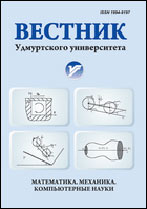|
|
Vestnik Udmurtskogo Universiteta. Matematika. Mekhanika. Komp'yuternye Nauki, 2014, Issue 4, Pages 76–83
(Mi vuu452)
|
 |
|
 |
This article is cited in 1 scientific paper (total in 1 paper)
MATHEMATICS
Quasi-levels of the Hamiltonian for a carbon nanotube
L. E. Morozovaa, Yu. P. Chuburinb
a Izhevsk State Technical University, ul. Studencheskaya, 7, Izhevsk, 426069, Russia
b Physical Technical Institute, Ural Branch of the Russian Academy of Sciences, ul. Kirova, 132, Izhevsk, 426000, Russia
Abstract:
In the past two decades, carbon nanotubes have been actively investigated in the physics literature, because of the promising prospects for their use in microelectronics; at the same time, interesting mathematical properties of used Hamiltonians, unfortunately, are often overlooked by mathematicians. In this paper, we carry out the mathematically rigorous investigation of spectral properties of the Hamiltonian $H_\varepsilon=H_0+\varepsilon V$, where the Hamiltonian $H_0$ of an electron in a zigzag carbon nanotube is written in the tight-binding approach, and the operator $\varepsilon V$ (potential) has the form
$$
(\varepsilon V\psi)(n)=\varepsilon {V_1\psi_1(n)\choose V_2\psi_2(n)}\delta_{n0}
$$
(here $\varepsilon>0$, $V_1,V_2$ are real numbers, $\delta_{n0}$ is the Kronecker delta). The Hamiltonian $H_\varepsilon$ corresponds to the carbon nanotube with an impurity uniformly distributed over the cross section of the nanotube. This Hamiltonian is the difference operator defined on functions from $(l^2(\Omega))^2$, where $\Omega=\mathbb Z\times\{0,1,\ldots,N-1\}$, $N\geqslant2$, satisfying the periodic boundary conditions. In particular, in this paper we prove that for each subband of the spectrum near one of the boundary points of the subband exactly one quasilevel (i.e. eigenvalue or resonance) exists in the case of small potentials. For quasilevels, the asymptotic formulas of the form
$$
\lambda _l^\pm=\pm\left|2\cos\frac{\pi l}N+1\right|\cdot\left(1+\frac{\varepsilon^2(V_1+V_2)^2}{16\cos\frac{\pi l}N}\right)+O(\varepsilon^3),
$$
are obtained, where $l$ is the subband number, $N$ is the number of atoms in the cross section of the nanotube, and $\pm$ is the sign of the $\lambda$. Also, we find the condition when a quasilevel is an eigenvalue.
Keywords:
Hamiltonian of a carbon nanotube, eigenvalue, resonance.
Received: 30.10.2014
Citation:
L. E. Morozova, Yu. P. Chuburin, “Quasi-levels of the Hamiltonian for a carbon nanotube”, Vestn. Udmurtsk. Univ. Mat. Mekh. Komp. Nauki, 2014, no. 4, 76–83
Linking options:
https://www.mathnet.ru/eng/vuu452 https://www.mathnet.ru/eng/vuu/y2014/i4/p76
|

|




 Contact us:
Contact us: Terms of Use
Terms of Use
 Registration to the website
Registration to the website Logotypes
Logotypes








 Citation in format
Citation in format 
